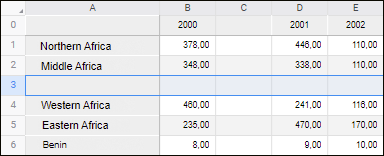 Insert rows
Insert rowsThe following operations with regular report rows are available:
There are two ways to insert a row:
Insert Row Below. The new row is added under the current one. Height of the added row will match the current row height.
Insert Row Above. The new row is added above the current one. Height of the added row will match height of the row above the current one.
NOTE. Adding rows is not available if a new row is in the data source table range.
To add a new row, select an existing row, or any cell in the row, and execute one of the following operations:
Select the  Insert Row Above context menu item or the
Insert Row Above context menu item or the  Insert Row Below item in the row header.
Insert Row Below item in the row header.
Select the  Insert >
Insert >  Insert Row Above context menu item or the
Insert Row Above context menu item or the  Insert > Insert Row Below item in the row cell.
Insert > Insert Row Below item in the row cell.
Press ALT+Y to insert a row above.
NOTE. If before inserting a row conditional formatting was set up for the range, it will also be applied to a new row.
After executing this command a new row is added into specified position, and the existing row moves to the opposite direction.
The example of inserting a row above when the 3 row is selected:

Multiple rows can be added at the same time. The number of inserted rows matches the number of initially selected rows.
There are several ways to change row height:
Changing Height Manually. To manually change row height, hover the cursor to the row's bottom border in the header area, click the border, hold down the cursor and drag it to the required distance. The actual row height is displayed in the tooltip.
Exact Height Change. To set precise value of row height, select the  Resize Row context menu item of the selected cell or row header. In the Row Height dialog box change row height value in pixels or millimeters:
Resize Row context menu item of the selected cell or row header. In the Row Height dialog box change row height value in pixels or millimeters:

Quick Row Height Fit. To quickly fit row height, execute one of the operations:
Select the  Fit Row Height context menu item of the selected cell or row header.
Fit Row Height context menu item of the selected cell or row header.
Click the  Fit Row Height button on the View toolbar tab.
Fit Row Height button on the View toolbar tab.
Select the View > Fit Row Height item in the selected cell's or row header's main menu.
Double-click the bottom border of the row header.
Each of the above-mentioned methods of row resize can be applied both to a single row and a group of rows. The changed size is applied to each row in the group.
Row hiding can be used when rows contain intermediate results. The data stored in hidden rows is not shown in the screen or on a printed sheet.
To hide a row, select the row (or any cell contained in the row) and select the  Hide item in the row header's context menu.
Hide item in the row header's context menu.
After executing this command the selected row is hidden. The row below it takes its place.
Multiple rows can be hidden at once.
To unhide the row, select two rows: above and below the hidden row, then select the  Show item in the selected rows header's context menu.
Show item in the selected rows header's context menu.
The hidden row between the selected rows is shown.
If there are several hidden rows between the selected rows, after selecting the  Show item all hidden rows will be shown.
Show item all hidden rows will be shown.
To delete a row, select required row (or any cell in this row), and execute one of the following operations:
Select the Delete Row item in the row header's context menu.
Delete Row item in the row header's context menu.
Select the  Delete > Delete Row context menu item of the cell contained in the row.
Delete > Delete Row context menu item of the cell contained in the row.
NOTE. The row is deleted even if only one row cell is selected.
After executing this command the selected row is deleted. The row below it takes its place.
NOTE. Deleting a row is not available if the deleted range includes a data source table.
Multiple rows can be deleted at once. To do this, before executing the operation, select a range that contains at least one cell of each of the rows to delete.
Variables in formulas are replaced in the following way:
When a row is deleted, all values that contain number of this row in their name, are replaced with "#REF!" in the formula. The cell values, which formulas contain references to the deleted row, are replaced with #REF
All values containing in their names a number that is less than the number of deleted row, remain unchanged.
All the values that have the number greater than the number of the deleted row in their name are reduced by one (A10 is replaced with A9, B10 with B9, and so on).
When rows are deleted, the system corrects formulas that include deleted (moved as a result of adding) cells located on other sheets of the regular report.
To fix the first row in the report area on scrolling, freeze row.
See also:
Working with Report Sheet Elements